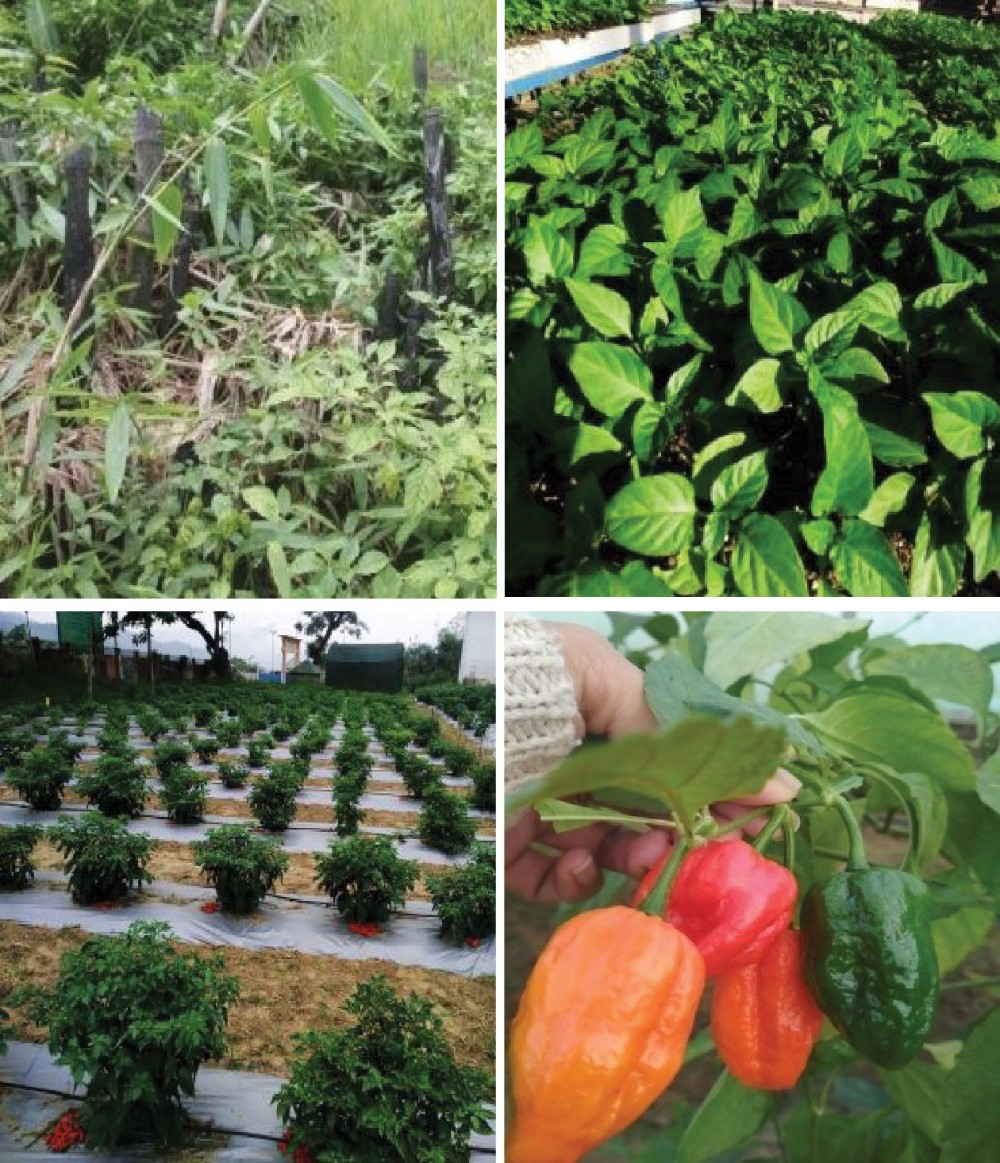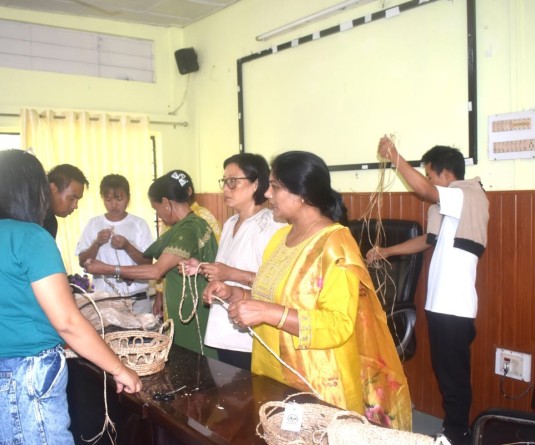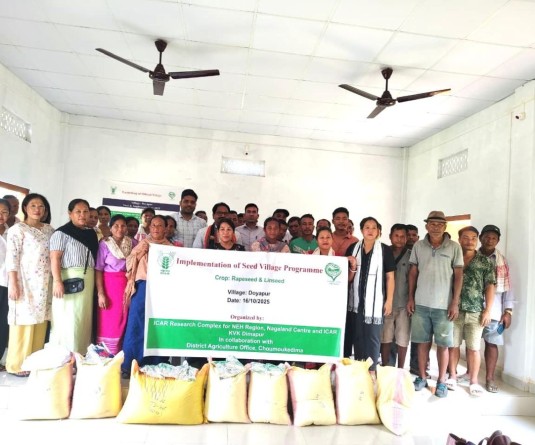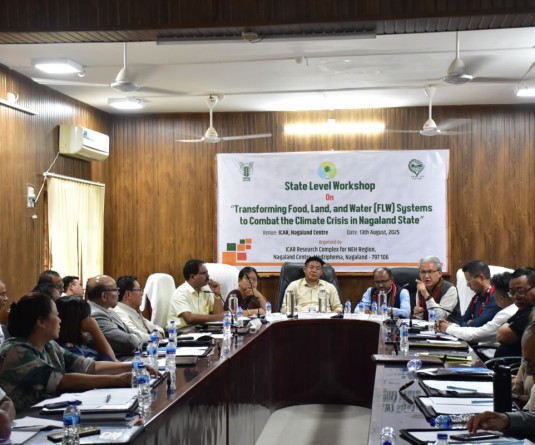
Azeze Seyie and Aabon W Yanthan
ICAR Research complex for NEH Region, Nagaland centre
Naga King chilli (Capsicum chinense) also locally called as raja mircha has been considered one of the hottest chilli in the world. The crop is native to the north-eastern part of India and Nagaland got the geographical indication tag as ‘Naga mircha’ in the year 2008. It is grown in almost all the districts of Nagaland and commercially cultivated well in Peren, Chümoukedima, Mon and Kohima district. It is an important spice crop preferred by most of the Jhum farmers which has very high market. Naga farmers traditionally grow this chilli in the jhum (shifting cultivation) fields sporadically intercropped with paddy and also in small homestead gardens. Most of the farmers practice direct seeding during March-April, preferably in a place where bamboo culms have been slashed and burned. Naga mircha thrives well in warm climate and grows in all types of soil, preferably in well drained and soil with high organic matter content.
Nursery preparation: Seeds can be sown in the first week of January to second week of February. Generally, it is raised by transplanting and about 1.5 kg seed is enough for planting a hectare. Nursery beds should be raised in partially shaded areas and the seeds sown thinly in lines spaced 5 cm apart. The medium of nursery bed is preferably a mixture of vermicompost, garden soil and sand (1:1:1). Sand and well decomposed compost are sprinkled over the seeds. Mulching with paddy straw soon after sowing conserves moisture. Seeds may also be sown in small polybags/ disposable cups/ plug trays. The seeds germinate in 10-15 days. Seedlings become ready for transplanting 40-45 days after sowing.
Planting and management practices: The field should be well prepared after ploughing to fine tilth. Well decomposed FYM @ 9-10 tons/ ha and vermicompost should be applied in pits @ 4-5 tons/ha, one week prior to transplanting and exposed it to sun.
Spacing: The seedlings can be transplanted at a spacing of 90-100 cm. Transplanting can be done in April-May with the onset of monsoon. Since chilli has a long growing season, it requires judicious application of manures. Use of biofertilizers such as Azotobacter and Azospirillium is recommended in chilli, with the latter giving better results. It can be applied as a seed treatment, seedling treatment and a direct application through soil. About 500 g seeds can be soaked in it and dried in shade for 30 minutes before sowing. For seedling treatment, slurry can be prepared by dissolving 40g of the bio-fertilizer in 2 litres of water. The roots should be dipped in the slurry for 15 minutes before transplanting. For soil application Azospirillium 2 kg/ha should be mixed with 20 kg FYM or compost.
Interculture operation: Earthing up should be done 30 days after transplanting and mulching should be done to conserve moisture and nutrients as well as prevent weed growth in the fields. Good results have also been obtained when grown with black polythene mulch of (25-30μ).
Disease and insect pest management: Careful seed selection and adoption of phytosanitary measures will check the diseases of chilli. For effective disease control, 10 g of Trichoderma or Pseudomonas sp per litre of water should be used for spraying. Drenching with Streptocycline 1 g/ 10 litres water at 60DAT to 120DAT has been found effective against bacterial wilt and 1 % Bordeaux mixture against fungal diseases. Anthracnose and fruit rot is a fungal disease caused by Colletotrichum capsici.
Necrosis of twigs occurs from tip downwards. Spots on fruits usually visible as sunken with black margins. So, seed treatment with Trichoderma @ 10g/kg seed is recommended. Leaf curl of chilli is another major problem which results in small and curled leaf, stunted plant growth and poor or no bearing. The infested plants should be uprooted/ burned/ buried. Spray of neem oil @ 5-8 ml/l of water after fruit setting to avoid the larval stage of fruit borer and control aphid population at economic threshold level. Use of yellow sticky traps can also be used to minimize the population of sap sucking pests like whiteflies and aphids. Growing of barrier crops as in growing of 2 rows of maize / 6 rows of chilli is also recommended to avoid the infestations of aphids and thrips.
Harvesting: In chilli, first picking should be done at green stage to stimulate further flush of flowers and fruit set. Chilli is generally harvested at fully grown green stage when grown for vegetable purpose, whereas for dried chilli fruits at red, ripe stage are ideal. On an average, a plant yields 1-1.5 kg of fresh fruits in 3-4 pickings. The fruits should be harvested, leaving the stalk intact in order to arrive in satisfactory condition at the place of destination. For processing of Naga mircha, such as pickles and sauces, the riped fruits are preferred. Since chillies qualify for an important earning commodity, its timely harvesting, curing and proper grading are very important.
Post harvest management and value addition: Though this crop has high potential, the market demands are barely met for various reasons amongst which, the post harvest loss is one of the pre-dominant factors. In order to combat the post harvest losses, post harvest management, processing and value addition is the need of the hour for tapping the potential of this high valued crop. Value added products such as Naga mircha pickle, sauce and puree is a remunerative option during peak season in order to tackle the post harvest losses and enhance shelf life.






